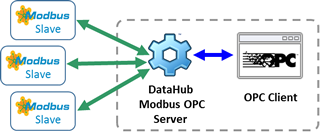
That is, Modbus TCP/IP uses a physical network (Ethernet), with a networking standard (TCP/IP), and itself offers a method of representing data (Modbus as the application protocol). Modbus TCP/IP uses Transmission Control Protocol (TCP) and Internet Protocol (IP) for the transmission of messages from Modbus between compatible devices over various systems. Modbus is an application protocol that assigns the ways of managing and passing data between various layers without being affected by the protocol used by the next immediate layer. Modbus TCP/IP is a simple Modbus protocol running on Ethernet over a TCP interface. Many of the data types are named from industry usage of Ladder logic and its use in driving relays: a single-bit physical output is called a coil, and a single-bit physical input is called a discrete input or a contact. Modbus is often used to connect a supervisory computer with a remote terminal unit (RTU) in supervisory control and data acquisition (SCADA) systems. Modbus enables communication among many devices connected to the same network, for example, a system that measures temperature and humidity and communicates the results to a computer.

Modbus has become a de facto standard communication protocol and is now a commonly available means of connecting industrial electronic devices.

MODBUS SERVER AS APPLICATION SERVER SERIAL
Modbus is a serial communications protocol originally published by Modicon (now Schneider Electric) in 1979 for use with its programmable logic controllers (PLCs).


 0 kommentar(er)
0 kommentar(er)
